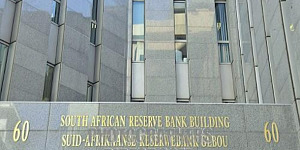Moody's Investors Service has today downgraded South Africa's government bond rating by one notch to Baa1 from A3. The rating outlook remains negative.
The key drivers for the downgrade include:
1. Moody's reassessment of a decline in the government's institutional strength amidst increased socio-economic stresses and the resulting diminished capacity to manage the growth and competitiveness risks.
2. Shrinking headroom for counter-cyclical policy actions, given the deterioration in the government's debt metrics since 2008, the uncertain revenue prospects and the already-low level of interest rates.
3. The challenges posed by a negative investment climate in light of infrastructure shortfalls, relatively high labour costs despite high unemployment, and increased concerns about South Africa's future political stability.
The rating outlook remains negative because of the uncertainty surrounding critical policy decisions that will be made at the upcoming National General Conference of the ruling African National Congress (ANC) party in December. The ANC's National Policy Conference at the end of June left many such discussion topics unresolved. South Africa's medium- to long-term political and economic stability depends crucially upon how well the party is able to coalesce the ongoing policy discussions into concrete and effective decisions by that time.
RATINGS RATIONALE
The main driver for the downgrade of South Africa's ratings is Moody's lowered assessment of institutional strength to "moderate" from "high," an important factor in the rating agency's judgment of a sovereign's economic resiliency. The revision reflects Moody's view of the South African authorities' reduced capacity to handle the current political and economic situation and to implement effective strategies that could place the economy on a path to faster and more inclusive growth. While the National Development Plan submitted by the country's National Planning Commission last November formulated a comprehensive set of reforms meant to lead to increased development and reduced inequality, Moody's notes that the fractious domestic environment is not conducive to the reforms being implemented at present. An example is the protracted debate once again of the proposal to introduce the subsidy for younger workers, who face a 50% unemployment rate, at June's National Policy Conference.
The second key driver for the downgrade is the reduced room for manoeuvre for counter-cyclical macroeconomic policy in light of the persistent deterioration in the government debt metrics over the past four years, as the rise in the wage bill and debt servicing costs reduces the amount of resources available for development spending. With government debt at around 40% of GDP, the fiscal space that had been created before the global crisis has now largely dissipated. The government is working towards a stabilisation of the debt-to-GDP ratio through increased spending discipline, which by moving the primary budget balance out of deficit would eventually restore some of the lost fiscal space. However, Moody's notes that these plans were recently rendered more challenging after the recent wage agreement with public-sector workers. Although the government had planned to rein in wage increases to 6% per annum over the next three years, the settlement was far more generous, thereby partially eroding the government's contingency reserve and probably reducing the ability to fill public sector job vacancies going forward.
The third driver informing Moody's decision to downgrade South Africa's sovereign rating is the more negative investment climate, which has been aggravated in recent years by shortfalls in energy, transportation and other infrastructure as well as high labour costs relative to productivity. In addition, investors' awareness of the country's long-standing socio-economic challenges, in particular the high unemployment rate and continuing wide income disparities nearly 20 years after the democratic transition, have been heightened following recent developments in the mining sector. Since the South African economy has a low savings rate, it is heavily dependent on foreign portfolio inflows to finance its rather large current account deficits. These non-debt-creating inflows have reliably funded the external deficits for many years, allowing the build-up of substantial foreign-exchange reserves at the central bank and significantly reducing the country's external vulnerability. Any reversal of those flows could be accommodated because of the flexibility of the exchange rate, the liquidity of the equity market and the foreign reserves cushion. However, Moody's cautions that economic growth would be further constrained in the unlikely event that foreign capital inflows shrink substantially.
The rating outlook remains negative because of uncertainty as to whether the policy decisions being devised ahead of the December leadership conference of the African National Congress will be helpful or detrimental to the country's growth and competitiveness outlook. The ANC's recommendations following the June policy conference called for "more radical policies and decisive action to effect thorough-going socio-economic and continued democratic transformation," suggesting that increasingly interventionist strategies are highly likely. To the extent that such strategies would deter private investment and incoming capital to South Africa, they could further diminish its growth potential at a difficult period in the global economy.
Moody's also has lowered South Africa's long-term country ceiling for foreign-currency debt to A2 from A1 and the ceiling for long-term foreign-currency deposits to Baa1 from A3. The local-currency ceilings for debt and deposits, previously Aa2, have been lowered to A1. Moody's will downgrade to a maximum rating of A1 all structured finance (SF) transactions backed by South African receivables currently rated above A1 on a global rating scale basis.
WHAT COULD CHANGE THE RATINGS UP/DOWN
Higher domestic savings and investment rates would support a stable outlook and potentially a rating upgrade, as would sustainably stronger growth, restrained debt accumulation and the maintenance of sound economic policies by the current administration and its successors.
The ratings could be downgraded should the government's debt and contingent liabilities rise much further, particularly if the deterioration occurs due to a pro-cyclical fiscal stance and/or heightened socio-political unrest that is not addressed in a manner consistent with future debt sustainability.
The principal methodology used in this rating was Sovereign Bond Ratings published in September 2008. Please see the Credit Policy page on www.moodys.com for a copy of this methodology.
REGULATORY DISCLOSURES
The Global Scale Credit Ratings on this press release that are issued by one of Moody's affiliates outside the EU are endorsed by Moody's Investors Service Ltd., One Canada Square, Canary Wharf, London E 14 5FA, UK, in accordance with Art.4 paragraph 3 of the Regulation (EC) No 1060/2009 on Credit Rating Agencies. Further information on the EU endorsement status and on the Moody's office that has issued a particular Credit Rating is available on www.moodys.com.
For ratings issued on a program, series or category/class of debt, this announcement provides relevant regulatory disclosures in relation to each rating of a subsequently issued bond or note of the same series or category/class of debt or pursuant to a program for which the ratings are derived exclusively from existing ratings in accordance with Moody's rating practices. For ratings issued on a support provider, this announcement provides relevant regulatory disclosures in relation to the rating action on the support provider and in relation to each particular rating action for securities that derive their credit ratings from the support provider's credit rating. For provisional ratings, this announcement provides relevant regulatory disclosures in relation to the provisional rating assigned, and in relation to a definitive rating that may be assigned subsequent to the final issuance of the debt, in each case where the transaction structure and terms have not changed prior to the assignment of the definitive rating in a manner that would have affected the rating. For further information please see the ratings tab on the issuer/entity page for the respective issuer on www.moodys.com.
Information sources used to prepare the rating are the following : parties involved in the ratings, parties not involved in the ratings, and public information.
Moody's considers the quality of information available on the rated entity, obligation or credit satisfactory for the purposes of issuing a rating.
Moody's adopts all necessary measures so that the information it uses in assigning a rating is of sufficient quality and from sources Moody's considers to be reliable including, when appropriate, independent third-party sources. However, Moody's is not an auditor and cannot in every instance independently verify or validate information received in the rating process.
Please see the ratings disclosure page on www.moodys.com for general disclosure on potential conflicts of interests.
Please see the ratings disclosure page on www.moodys.com for information on (A) MCO's major shareholders (above 5%) and for (B) further information regarding certain affiliations that may exist between directors of MCO and rated entities as well as (C) the names of entities that hold ratings from MIS that have also publicly reported to the SEC an ownership interest in MCO of more than 5%. A member of the board of directors of this rated entity may also be a member of the board of directors of a shareholder of Moody's Corporation; however, Moody's has not independently verified this matter.
Please see Moody's Rating Symbols and Definitions on the Rating Process page on www.moodys.com for further information on the meaning of each rating category and the definition of default and recovery.
Please see ratings tab on the issuer/entity page on www.moodys.com for the last rating action and the rating history.
The date on which some ratings were first released goes back to a time before Moody's ratings were fully digitized and accurate data may not be available. Consequently, Moody's provides a date that it believes is the most reliable and accurate based on the information that is available to it. Please see the ratings disclosure page on our website www.moodys.com for further information.
Please see www.moodys.com for any updates on changes to the lead rating analyst and to the Moody's legal entity that has issued the rating.
Source: Moody's























































